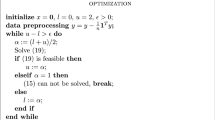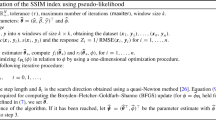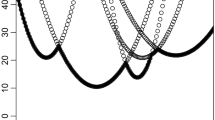Abstract
This paper focuses on the construction of image similarity indices that consider the hidden spatial association between two images. The proposal is a variant of a structural similarity (SSIM) coefficient and introduces a codispersion coefficient to capture the hidden spatial association between two images in a particular direction on a plane. The novel contribution of this article is the inclusion of the codispersion coefficient instead of the sample correlation coefficient. The difference between the codispersion and correlation coefficients is illustrated through two examples. We then show that this modified measure is a valid pseudo metric and has several useful properties, including quasi-convexity, which is established under very precise conditions. The quasi-convexity property is an attractive property that allows one to use this type of measure as a cost function in optimization problems. In addition, we introduce another variant of the SSIM with a contrast function that depends on the spatial lag on the space. This proposal trivially recovers the optimization properties of the SSIM. Various computational experiments with real datasets support our proposals and findings, and we characterize the practical advantages and drawbacks of the SSIM variants.






Similar content being viewed by others
References
Basu, S., Reinsel, G.: Properties of the spatial unilateral first-order ARMA model. Adv. Appl. Probab. 25, 631–648 (1993)
Boyd, S., Banderberghe, L.: Convex Optimization. Cambridge University Press, New York (2004)
Brunet, D., Vrscay, E.R., Wanng, Z.: On the mathematical properties of the structural similarity index. IEEE Trans. Image Process. 21, 1488–1498 (2012b)
Chandler, D.M., Hemami, S.S.: VSNR: a wevelet-based visual signal-to-noise-ratio for natural images. IEEE Trans. Image Process. 9, 2284–2298 (2007)
Chilès, J.P., Delfiner, P.: Geostatistics: Modeling Spatial Uncertainty. Wiley, New York (1999)
Clifford, P., Richardson, S., Hémon, D.: Assessing the significance of the correlation between two spatial processes. Biometrics 45, 123–134 (1989)
Cramer, H.: On the theory of stationaryrandom processes. Ann. Math. 41, 215–230 (1940)
Cuevas, F., Porcu, E., Vallejos, R.: Study of spatial relationships between two sets of variables: a nonparametric approach. J. Nonparametr. Stat. 25, 695–714 (2013)
Dutilleul, P.: Modifying the \(t\) test for assessing the correlation between two spatial processes. Biometrics 49, 305–314 (1993)
Duttilleul, P., Pelletier, B., Alpargu, G.: Modified F tests for assessing the multiple correlation between one spatial process and several others. J. Stat. Plan. Inference 138, 1402–1415 (2008)
Genton, M.: Highly robust robust variogram estimation. Math. Geol. 30, 213–221 (1998)
Hubert, L.J., Golledge, R.G.: Measuring association between spatially defined variables: Tjostheim index and some extensions. Geogr. Anal. 4, 273–278 (1982)
Larson, E.C., Chandler, D.M.: Most aparent distortion: full reference image quality assessment and the role of the strategy. J. Electron. Imaging 19, 011006 (2010)
Martin, R.J.: Some results on unilateral ARMA lattice processes. J. Stat. Plan. Inference 50, 395–411 (1996)
Matheron, G.: Les Variables Regionalisees et leur Estimation. Masson, Paris (1965)
Ojeda, S., Vallejos, R., Lamberti, P.W.: Measure of similarity between images based on the codispersion coefficient. J. Electron. Imaging 21, 023019 (2012)
Richardson, S., Clifford, P.: Testing association between spatial processes. In: Possolo, A. (ed.) Spatial Statistics and Imaging: Papers from the Research Conference on Image Analysis and Spatial Statistics Held at Bowdoin College, Brunswick, ME, Summer 1988. IMS Lecture Notes, vol. 20, pp. 295–308 (1991)
Rukhin, A., Vallejos, R.: Codispersion coefficient for spatial and temporal series. Stat. Probab. Lett. 78, 1290–1300 (2008)
Osorio, F., Vallejos, R.: SpatialPack—an R package for computing the association between two spatial or temporal processes (2012)
Ponomarenko, N., Jin, L., Ieremeiev, O., Lukin, V., Egiazarian, K., Astola, J., Vozel, B., Chehdi, K., Carli, M., Battisti, F., Kuo, C.C.J.: Image database TID2013:peculiarities, results and perspectives. Signal Process. Image Commun. 30, 57–77 (2015)
Sampat, M.P., Wang, Z., Gupta, S., Bovik, A.C.: Complex wavelet structural similarity: a new image similarity index. IEEE Trans. Image Process. 18, 2385–2401 (2009)
Sheikh, H.R., Bovik, C.: Image information and visual quality. IEEE Trans. Image Process. 15, 430–444 (2006)
Silvestre-Blanes, J.: Structural similarity image quality reliability determining parameters and window size. Signal Process. 91, 1012–1020 (2011)
Tjstheim, D.: A measure of association for spatial variables. Biometrika 65, 109–114 (1978)
Vallejos, R.: Assessing the association between two spatial or temporal sequences. J. Appl. Stat. 35, 1323–1343 (2008)
Vallejos, R.: Testing for the absence of correlation between two spatial or temporal sequences. Pattern Recognit. Lett. 33, 1741–1748 (2012)
Vallejos, R., Mallea, A., Herrera, M., Ojeda, S.: A multivariate geostatistical approach for landscape classification from remotely sensed image data. Stoch. Environ. Res. Risk Assess. 29, 369–378 (2015)
Vallejos, R., Osorio, F., Mancilla, D.: The codispersion map: a graphical tool to visualize the association between two spatial processes. Stat. Neerl. 69, 298–314 (2015)
Wang, Z., Bovik, C.: A universal image quality index. IEEE Signal Process. Lett. 9, 81–84 (2002)
Wang, Z., Zimoncelli, E.P., Bovik, C.: Multi-scale structural similarity for image quality assessment. In: Proceedings of the IEEE Asilomar Conference Signals, Systems, and Computers, Pacific Grove, CA, pp. 1398–1402 (2003)
Wang, Z., Bovik, A., Sheikh, H.R., Simoncelli, E.P.: Image quality assessment: from error visibility to structural similarity. IEEE Trans. Image Process. 13, 1–14 (2004)
Wang, Z., Bovik, C.: Mean squared error: love it or leave it? A new look at signal fidelity measures. IEEE Signal Process. Mag. 26, 98–117 (2009)
Wang, Z., Li, Q.: Information content weighting for perceptual image quality assessment. IEEE Trans. Image Process. 20, 1185–1198 (2011)
Yaglom, A.M.: Correlation Theory of Stationary and Related Random Functions. Springer, Berlin (1986)
Yank, M.C.K., Schreckengost, J.F.: Difference sign test for comovements between two time series. Commun. Stat. Theory Methods A10, 355–369 (1981)
Zhang, L., Zhang, L., Mou, X., Zhang, D.: A feature similarity index for image quality assessment. IEEE Trans. Image Process. 20, 2378–2386 (2011)
Acknowledgments
Ronny Vallejos was partially supported by Fondecyt Grant No. 1120048, Chile, and an AC3E Grant No. FB-0008. Part of this article was written while he was visiting the UFMG in Belo Horizonte, Brazil. Ronny Vallejos is also grateful to Assuncao and Rosangela Loschi for their hospitality and kindness. The authors want to thank Felipe Osorio and Ángelo Gárate for their helpful discussions. The authors also acknowledge the suggestions from two anonymous referees, an associate editor, and the editor of JMIV that helped to improve the manuscript.
Author information
Authors and Affiliations
Corresponding author
Electronic supplementary material
Below is the link to the electronic supplementary material.
Appendix: Proofs
Appendix: Proofs
1.1 Derivation of (6)
Assuming that the parameters of the models lie in the stationary region, the following representations hold:
Then, we compute the term \({\mathbb {E}}[X(i,j)Y(i,j)]\), thereby obtaining
We recall that this expression is valid when \(\phi _i\ne 0\), \(\psi _i\ne 0\), \(i=1,2,3\) and when the summation is over all non-negative k, l, m, r such that \((k+m-r)\ge 0\) and \((l+m-r)\ge 0\). Now, we define
Using (50), we obtain
Replacing the above quantities in (2), one obtains Equation (6), where \(K=\frac{K_1}{2R_1R_2}\) and
Proof of Proposition 1
For the proof of Proposition 1, we need to establish the following lemma. \(\square \)
Lemma 2
A spatial lag \({\varvec{h}}=(h_1,h_2)\) that belongs to a rectangular grid of \(\mathbb {Z}^{2}_{+}\) induces a lag \(h^{*}>0\) in the space of images \(\mathbb {R}_+^N.\)
Proof
Let n, m \(\in \mathbb {Z}_{+}\) be the number of rows and columns, respectively, of a rectangular grid of \(\mathbb {Z}^{2}_{+}\). Then, the spatial lag \({\varvec{h}}=(h_1,h_2)\in \mathbb {Z}^2_{+}\) corresponds to a translation of \(h_1\) units to the right and \(h_2\) units down (depending on the convention used). Thus, for \(\mathrm {{\varvec{X}}}\), fixing the point \({\varvec{s}}=(i,j)\in S_{{\varvec{h}}},\) we have that if \((i,j)\mapsto k\), then \((i+h_1,j+h_2)\mapsto k+h^*\), where \(h^*=h_1+nh_2\).
Note that Lemma 2 is valid if the spatial lag \({{\varvec{h}}}\) is a valid position on the image, i.e., \((i+h_1,j+h_2)\) is a point belonging to the rectangular grid.
Proof of Proposition 1
The proof is developed by construction. Let \({{\varvec{h}}}=(h_1,h_2)\in \mathbb {Z}^{2}_{+}\) be a fixed spatial lag; let \(h^{*}\) be the lag induced by \({{\varvec{h}}}\) according to Lemma 2; let us denote by \({\varvec{I}}_{k}\) the identity matrix of order \(k\times k\) and by \({\varvec{0}}_{k,l}\) the null matrix of order \(k\times l\); and let \({\varvec{A}}_{{\varvec{h}}}^{(1)}\) be a matrix of order \(n-h_1\times N\) such that
Similarly, we define the following quantities:
where \(k=1,\ldots ,m-h_2\).
In the previous calculations, for a given matrix \({{\varvec{X}}}\) of order \(n\times m\) and a spatial lag \({{\varvec{h}}}=(h_1,h_2)\), \(|S_{{\varvec{h}}}|=N_{{{\varvec{h}}}}=(n-h_1)(m-h_2)\) is implicit. Hence, defining
it is straightforward to obtain
where \(S_{{\varvec{h}}}^{im} =\{k: 1\le k\le nm \wedge F^{-1}(k)\in S_{{\varvec{h}}}\}, \) and F is the natural map associated with the indices given by
Clearly, F is a bijective map between \(S_{{\varvec{h}}}\) and \(S_{{\varvec{h}}}^{im}\). Because \(N_{{\varvec{h}}}=(n-h_1)(m-h_2)\), the result follows after simple calculations of the norms and inner products.
Proof of Proposition 5
Without loss of generality, we assume that \(h_1,h_2\ge 0\). \(h_1\) corresponds to a column translation of the matrix \({{\varvec{X}}}\), and \(h_2\) corresponds to a row translation of \({{\varvec{X}}}.\) Now, \({\varvec{A}}_{{\varvec{h}}}{\varvec{x}}\) is equal to the vector \({\varvec{x}}_{{\varvec{h}}}= ({\varvec{X}}(j,i)-{\varvec{X}}(j+h_2,i+h_1)),\) for all \((j,i)\ \text {such that} \ (j+h_2,i+h_1)\in [1,2,\ldots ,n]\times [1,2,\ldots ,m].\) Specifically,
Clearly, every pixel belonging to the subimage
appears once with a positive sign and once with a negative sign in \({\varvec{x}}_{{\varvec{h}}}\); thus, they do not contribute to the sum of the entries of \({\varvec{x}}_{{\varvec{h}}}\). The terms that remain are those that are located outside of the central subimage. Among them, the terms that are in \(L_+=\{{\varvec{X}}(j,i):\quad (j,i)\in [1,\ldots ,h_2]\times [1,\ldots ,m-h_1]\cup [h_2+1,\ldots ,n-h_2]\times [1,\ldots ,h_1]\}\) have a positive sign, while those that are in \(L_{-}=\{{{\varvec{X}}}(j,i):\quad (j,i)\in [n-h_2,\ldots ,n]\times [h_1,\ldots ,m]\cup [n-h_1+1,\ldots ,n]\times [h_2+1,n-h_2]\}\) have a negative sign. Given that the intensities of the central part of the image is zero, we want the components of \({\varvec{x}}_{{\varvec{h}}}\) that have the same property. Then, we require that
Using the definition of \(L_{+}\) and \(L_{-}\), it is straightforward to prove that Equation (51) is equivalent to
This completes the proof.
As an illustration of the terms used in the proof of Proposition 5, Fig. 7 shows an example with an image of size \(9\times 9\) and a spatial lag \({\varvec{h}}=(1,2).\) The sign displayed in each cell shows whether the term associated with that cell can be positive, negative, or both when applying the transformation \({\varvec{A}}_{{\varvec{h}}}\) to \({\varvec{x}}=\mathrm {vec}({\varvec{X}}).\) We observe from Fig. 7 that the subimage I corresponds to the area colored in green. \(L_+\) corresponds to the area colored in light blue, while \(L_+\) corresponds to the red area. The gray cells are those pixels that are not used in the construction of \({\varvec{x}}_{{\varvec{h}}}\) and are located at the upper-right corner and at the bottom-left corner of the matrix shown in Fig. 7 .
Example of the terms used in the proof of Proposition 5 for an image of size \(9 \times 9\) and \({{\varvec{h}}}=(1,2)\)
Proof of Proposition 9
We have to prove that \({\varvec{H}}_g{\varvec{v}}^{\lambda }=\lambda {\varvec{v}}^{\lambda },\) where \(\lambda \) and \({\varvec{v}}^{\lambda }\) are as in (36) and (37).
Let \(v_k^{\lambda }\), \(k=1,\ldots ,N\) be the components of \({\varvec{v}}^{\lambda }\), and let \({\varvec{H}}^{k}_{g}\) be the vector associated with the k-th row of \({\varvec{H}}_{g}\). We will prove that
Let \(k>1\). Using the partial derivatives given by
we have that
If \(k=1\), the left-hand side of Eq. (52) is
Now, the right-hand side of Equation (52) is given by
Because the expressions (57) and (58) are equal, the proof for \(k=1\) is complete. This concludes the proof.
Proof of (40) and (41)
The proof is similar to that of Proposition 9. First, note that
Then, if \(k=1\), we obtain
If \(k>1\), one obtains
Rights and permissions
About this article
Cite this article
Vallejos, R., Mancilla, D. & Acosta, J. Image Similarity Assessment Based on Coefficients of Spatial Association. J Math Imaging Vis 56, 77–98 (2016). https://doi.org/10.1007/s10851-016-0635-y
Received:
Accepted:
Published:
Issue Date:
DOI: https://doi.org/10.1007/s10851-016-0635-y





